- ▶
- Heaters/Source
- ▶
- Agilent Heaters and SensorsMass Spectrometry, Scientific Supplies & ManufacturingScientific Instrument Services 5973 Source Heater Tamper Resistant Allen Wrench 5973/5975 Quad Sensor 5985 Source Heater Assembly Agilent Interface Heater Assembly 5971 Interface Heater

- ▶
- Filaments
- LiteratureApplication Notes Adsorbent Resins Guide Mass Spec Tips SDS Sheets FAQ MS Calibration Compound Spectra Manuals MS Links/Labs/ Organizations MS Online Tools Flyers on Products/Services Scientific Supplies Catalog About Us NextAdvance Bullet Blender® Homogenizer Protocols Micro-Mesh® Literature Instrumentation Literature Agilent GC/MS Literature SIS News / E-Mail Newsletter NIST MS Database - Update Notifications

- ▶
- Application NotesNote 103: EPA Method 325B, Novel Thermal Desorption Instrument Modification to Improve Sensitivity Note 102: Identification of Contaminants in Powdered Beverages by Direct Extraction Thermal Desorption GC/MS Note 101: Identification of Contaminants in Powdered Foods by Direct Extraction Thermal Desorption GC/MS Note 100: Volatile and Semi-Volatile Profile Comparison of Whole Versus Cracked Versus Dry Homogenized Barley Grains by Direct Thermal Extraction Note 99: Volatile and Semi-Volatile Profile Comparison of Whole vs. Dry Homogenized Wheat, Rye and Barley Grains by Direct Thermal Extraction GC/MS Note 98: Flavor and Aroma Profiles of Truffle Oils by Thermal Desorption GC/MS Note 97: Flavor Profiles of Imported and Domestic Beers by Purge & Trap Thermal Desorption GC/MS Note 96: Reducing Warping in Mass Spectrometer Filaments, with SISAlloy® Yttria/Rhenium Filaments Note 95: Detection of Explosives on Clothing Material by Direct and AirSampling Thermal Desorption GC/MS Note 94: Detection of Nepetalactone in the Nepeta Cataria Plant by Thermal Desorption GC/MS Note 93: Detection of Benzene in Carbonated Beverages with Purge & Trap Thermal Desorption GC/MS Note 92: Yttria Coated Mass Spectrometer Filaments Note 91: AutoProbe DEP Probe Tip Temperatures Note 90: An Automated MS Direct Probe for use in an Open Access Environment Note 89: Quantitation of Organics via a Mass Spectrometer Automated Direct Probe Note 88: Analysis of Silicone Contaminants on Electronic Components by Thermal Desorption GC-MS Note 87: Design and Development of an Automated Direct Probe for a Mass Spectrometer Note 86: Simulation of a Unique Cylindrical Quadrupole Mass Analyzer Using SIMION 7.0. Note 85: Replacing an Electron Multiplier in the Agilent (HP) 5973 MSD Note 84: Vacuum Pump Exhaust Filters - Charcoal Exhaust Traps Note 83: Vacuum Pump Exhaust Filters - Oil Mist Eliminators Note 82: Vacuum Pump Exhaust Filters Note 81: Rapid Bacterial Chemotaxonomy By DirectProbe/MSD Note 80: Design, Development and Testing of a Microprocessor ControlledAutomated Short Path Thermal Desorption Apparatus Note 79: Volatile Organic Compounds From Electron Beam Cured and Partially Electron Beam Cured Packaging Using Automated Short Path Thermal Desorption Note 78: A New Solution to Eliminate MS Down-Time With No-Tool-Changing of Analytical GC Columns Note 77: The Determination of Volatile Organic Compounds in VacuumSystem Components Note 76: Determination of the Sensitivity of a CRIMS System Note 75: An Apparatus for Sampling Volatile Organics From LivePlant Material Using Short Path Thermal Desorption Note 74: Examination of Source Design in Electrospray-TOF Using SIMION 3D Note 73: The Analysis of Perfumes and their Effect on Indoor Air Pollution Note 72: 1998 Version of the NIST/EPA/NIH Mass Spectral Library, NIST98 Note 71: Flavor Profile Determination of Rice Samples Using Shor tPath Thermal Desorption GC Methods Note 70: Application of SIMION 6.0 To a Study of the Finkelstein Ion Source: Part II Note 69: Application of SIMION 6.0 To a Study of the Finkelstein Ion Source: Part 1 Note 68: Use of a PC Plug-In UV-Vis Spectrometer To Monitor the Plasma Conditions In GC-CRIMS Note 67: Using Chemical Reaction Interface Mass Spectrometry (CRIMS) To Monitor Bacterial Transport In In Situ Bioremediation Note 66: Probe Tip Design For the Optimization of Direct Insertion Probe Performance Note 65: Determination of Ethylene by Adsorbent Trapping and Thermal Desorption - Gas Chromatography Note 64: Comparison of Various GC/MS Techniques For the Analysis of Black Pepper (Piper Nigrum) Note 63: Determination of Volatile and Semi-Volatile Organics in Printer Toners Using Thermal Desorption GC Techniques Note 62: Analysis of Polymer Samples Using a Direct Insertion Probe and EI Ionization Note 61: Analysis of Sugars Via a New DEP Probe Tip For Use With theDirect Probe On the HP5973 MSD Note 60: Programmable Temperature Ramping of Samples Analyzed ViaDirect Thermal Extraction GC/MS Note 59: Computer Modeling of a TOF Reflectron With Gridless Reflector Using SIMION 3D Note 58: Direct Probe Analysis and Identification of Multicomponent Pharmaceutical Samples via Electron Impact MS Note 57: Aroma Profiles of Lavandula species Note 56: Mass Spec Maintenance & Cleaning Utilizing Micro-Mesh® Abrasive Sheets Note 55: Seasonal Variation in Flower Volatiles Note 54: Identification of Volatile Organic Compounds in Office Products Note 53: SIMION 3D v6.0 Ion Optics Simulation Software Note 52: Computer Modeling of Ion Optics in Time-of-Flight mass Spectrometry Using SIMION 3D Note 51: Development and Characterization of a New Chemical Reaction Interface for the Detection of Nonradioisotopically Labeled Analytes Using Mass Spectrometry (CRIMS) Note 50: The Analysis of Multiple Component Drug Samples Using a Direct Probe Interfaced to the HP 5973 MSD Note 49: Analysis of Cocaine Utilizing a New Direct Insertion Probe on a Hewlett Packard 5973 MSD Note 48: Demonstration of Sensitivity Levels For the Detection of Caffeine Using a New Direct Probe and Inlet for the HP 5973 MSD Note 47: The Application Of SIMION 6.0 To Problems In Time-of-Flight Mass Spectrometry Note 46: Delayed Extraction and Laser Desorption: Time-lag Focusing and Beyond Note 45: Application of SIMION 6.0 to Filament Design for Mass Spectrometer Ionization Sources Note 44: The Design Of a New Direct Probe Inlet For a Mass Spectrometer Note 43: Volatile Organic Composition In Blueberries Note 42: The Influence of Pump Oil Purity on Roughing Pumps Note 41: Hydrocarbon Production in Pine by Direct Thermal Extraction Note 40: Comparison of Septa by Direct Thermal Extraction Note 39: Comparison of Sensitivity Of Headspace GC, Purge and Trap Thermal Desorption and Direct Thermal Extraction Techniques For Volatile Organics Note 38: A New Micro Cryo-Trap For Trapping Of Volatiles At the Front Of a GC Capillary Column Note 37: Volatile Organic Emissions from Automobile Tires Note 36: Identification Of Volatile Organic Compounds In a New Automobile Note 35: Volatile Organics Composition of Cranberries Note 34: Selection Of Thermal Desorption and Cryo-Trap Parameters In the Analysis Of Teas Note 33: Changes in Volatile Organic Composition in Milk Over Time Note 32: Selection and Use of Adsorbent Resins for Purge and Trap Thermal Desorption Applications Note 31: Volatile Organic Composition in Several Cultivars of Peaches Note 30: Comparison Of Cooking Oils By Direct Thermal Extraction and Purge and Trap GC/MS Note 29: Analysis Of Volatile Organics In Oil Base Paints By Automated Headspace Sampling and GC Cryo-Focusing Note 28: Analysis Of Volatile Organics In Latex Paints By Automated Headspace Sampling and GC Cryo-Focusing Note 27: Analysis of Volatile Organics In Soils By Automated Headspace GC Note 26: Volatile Organics Present in Recycled Air Aboard a Commercial Airliner Note 25: Flavor and Aroma in Natural Bee Honey Note 24: Selection of GC Guard Columns For Use With the GC Cryo-Trap Note 23: Frangrance Qualities in Colognes Note 22: Comparison Of Volatile Compounds In Latex Paints Note 21: Detection and Identification Of Volatile and Semi-Volatile Organics In Synthetic Polymers Used In Food and Pharmaceutical Packaging Note 20: Using Direct Thermal Desorption to Assess the Potential Pool of Styrene and 4-Phenylcyclohexene In Latex-Backed Carpets Note 19: A New Programmable Cryo-Cooling/Heating Trap for the Cryo-Focusing of Volatiles and Semi-Volatiles at the Head of GC Capillary Columns Note 18: Determination of Volatile Organic Compounds In Mushrooms Note 17: Identification of Volatile Organics in Wines Over Time Note 16: Analysis of Indoor Air and Sources of Indoor Air Contamination by Thermal Desorption Note 14: Identification of Volatiles and Semi-Volatiles In Carbonated Colas Note 13: Identification and Quantification of Semi-Volatiles In Soil Using Direct Thermal Desorption Note 12: Identification of the Volatile and Semi-Volatile Organics In Chewing Gums By Direct Thermal Desorption Note 11: Flavor/Fragrance Profiles of Instant and Ground Coffees By Short Path Thermal Desorption Note 10: Quantification of Naphthalene In a Contaminated Pharmaceutical Product By Short Path Thermal Desorption Note 9: Methodologies For the Quantification Of Purge and Trap Thermal Desorption and Direct Thermal Desorption Analyses Note 8: Detection of Volatile Organic Compounds In Liquids Utilizing the Short Path Thermal Desorption System Note 7: Chemical Residue Analysis of Pharmaceuticals Using The Short Path Thermal Desorption System Note 6: Direct Thermal Analysis of Plastic Food Wraps Using the Short Path Thermal Desorption System Note 5: Direct Thermal Analysis Using the Short Path Thermal Desorption System Note 4: Direct Analysis of Spices and Coffee Note 3: Indoor Air Pollution Note 2: Detection of Arson Accelerants Using Dynamic Headspace with Tenax® Cartridges Thermal Desorption and Cryofocusing Note 1: Determination of Off-Odors and Other Volatile Organics In Food Packaging Films By Direct Thermal Analysis-GC-MS Tech No. "A" Note 14: Elimination of "Memory" Peaks in Thermal Desorption Improving Sensitivity in the H.P. 5971 MSD and Other Mass Spectrometers - Part I of II Improving Sensitivity in the H.P. 5971 MSD and Other Mass Spectrometers- Part II of II Adsorbent Resins Guide Development and Field Tests of an Automated Pyrolysis Insert for Gas Chromatography. Hydrocarbon Production in Pine by Direct Thermal Extraction A New Micro Cryo-Trap for the Trapping of Volatiles at the Front of a GC Capillary (019P) - Comparison of Septa by Direct Thermal Extraction Volatile Organic Composition in Blueberry Identification of Volatile Organic Compounds in Office Products Detection and Indentification of Volatiles in Oil Base Paintsby Headspace GC with On Column Cryo-Trapping Evaluation of Septa Using a Direct Thermal Extraction Technique INFLUENCE OF STORAGE ON BLUEBERRY VOLATILES Selection of Thermal Desorption and Cryo-Trap Parameters in the Analysis of Teas Redesign and Performance of a Diffusion Based Solvent Removal Interface for LC/MS The Design of a New Direct Probe Inlet for a Mass Spectrometer Analytes Using Mass Spectrometry (CRIMS) Application of SIMION 6.0 to Filament Design for Mass Spectrometer Ionization Sources A Student Guide for SIMION Modeling Software Application of SIMION 6.0 to Problems in Time-of-flight Mass Spectrometry Comparison of Sensitivity of Headspace GC, Purge and TrapThermal Desorption and Direct Thermal Extraction Techniques forVolatile Organics The Influence of Pump Oil Purity on Roughing Pumps Analysis of Motor Oils Using Thermal Desorption-Gas Chromatography-Mass Spectrometry IDENTIFICATION OF VOLATILE ORGANIC COMPOUNDS IN PAPER PRODUCTS Computer Modeling of Ion Optics in Time-of-Flight mass Spectrometry using SIMION 3D Seasonal Variation in Flower Volatiles Development of and Automated Microprocessor Controlled Gas chromatograph Fraction Collector / Olfactometer Delayed Extraction and Laser Desorption: Time-lag Focusing and Beyond A New Micro Cryo-Trap for the Trapping of Volatiles at the Front of a GC Column Design of a Microprocessor Controlled Short Path Thermal Desorption Autosampler Computer Modeling of Ion Optics in Time-of-Flight Mass Spectrometry Using SIMION 3D Thermal Desorption Instrumentation for Characterization of Odors and Flavors

- ▶
- Note 96: Reducing Warping in Mass Spectrometer Filaments, with SISAlloy® Yttria/Rhenium Filaments (This Page)
By John J. Manura, Christopher Baker & Ronald Shomo
Scientific Instrument Services, Ringoes, NJ
Presented at the ASMS Meeting in Denver, CO, June 2011
Introduction
Filament warping is a significant problem in the mass spectrometer especially in Chemical Ionization (CI) sources where the ion entrance hole is small. Different filament materials and geometry have been used to reduce or eliminate this problem. Various wire geometries including ribbon filaments, straight wire filaments, coils and pin shaped filaments were studied using a variety of filament materials including Rhenium, Tungsten, Rhenium/Tungsten alloy and Yttria/Rhenium * (Yttrium Oxide/Rhenium) alloy materials to evaluate the effect of these parameters on filament warping.
Previous studies have shown that round wire filaments are less likely to warp as compared to thin ribbon shaped filaments. Additional studies show that the straight wire filaments demonstrate less warping than the coil or pin shaped filaments.
Rhenium is a very ductile material compared to Tungsten or the Tungsten/Rhenium materials. However Rhenium has been the preferred material for filament construction, since it does not oxidize and form oxide crystals on the filament like the Tungsten filament materials. However because it is soft, Rhenium filaments easily warp especially in a coil or pin shaped geometry.
Rhenium has been alloyed with several other refractory materials at low concentrations to improve the rigidity of the Rhenium. Tungsten was tried first, but the wire was difficult to draw. Low concentrations of Yttria were alloyed with Rhenium. The Yttria/Rhenium alloy proved to have identical electrical characteristics to the pure Rhenium, but filament warping was dramatically reduced with this material.
Method
Filaments were constructed from pure Rhenium, Tungsten, 3% Rhenium-Tungsten, and a Yttria/Rhenium alloy. A variety of filament shapes including straight filaments, coils and pin shaped filaments were tested using a multi-filament DC supply filament testing station and also in several different manufacturers™ mass spectrometers to monitor their performance and to determine filament lifetime cycles and to monitor filament warping. The filaments were tested by cycling the filaments ON and OFF every 60 seconds until the filament sensitivity declined or the filament burned out.
The crystal structure of Yttria/Rhenium alloy was studied by Electron microscopy and demonstrated that the yttria oxide particles intermixed with the rhenium particles reducing the size of the Rhenium crystals in the filament material. In comparison, the pure rhenium filaments exhibited larger and longer grain sizes. This smaller grain size in the alloy filament appears to strengthen the filament wire to provide a more stable filament that displays less sag or warping than pure rhenium filaments. The property of reduced warping has been demonstrated for straight wire filaments, multiple coiled filaments and pin shaped filaments when used in both AC and DC filament operating circuits.
Straight Wire CI Filaments
Straight wire filaments were constructed from 0.0055” diameter pure Rhenium, Yttria/Rhenium alloy and 3%Rhemium/97% Tungsten. Filaments were tested in a mass spectrometer under CI conditions using Methane as the gas and helium as the GC carrier gas. Themass spectrometer utilized a high frequency AC filament power supply. Both the Y/Re and W/Re filaments exhibited longer filament life with minimal warping.
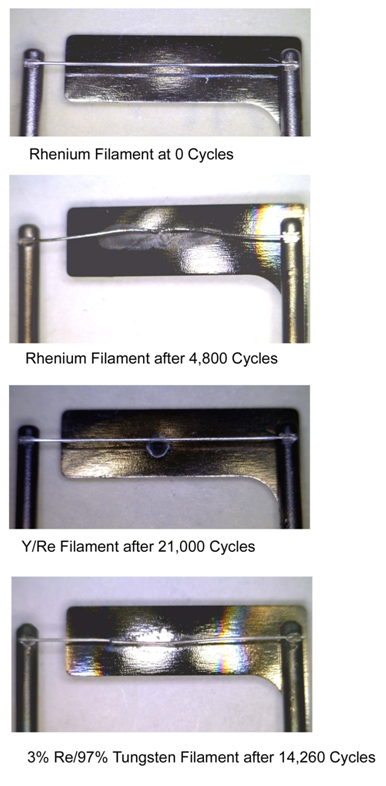
Coil Filaments - 2 Coils
Two coil filaments were constructed from 0.0055” diameter Yttria/Rhenium alloy and pure Rhenium. Testing was done in an EI mass spectrometer using a high frequency AC filament power supply. Multiple Re filaments demonstrate the consistent warping seen with pure rhenium filaments, where as the Y/Re alloy filaments did not exhibit this warping.
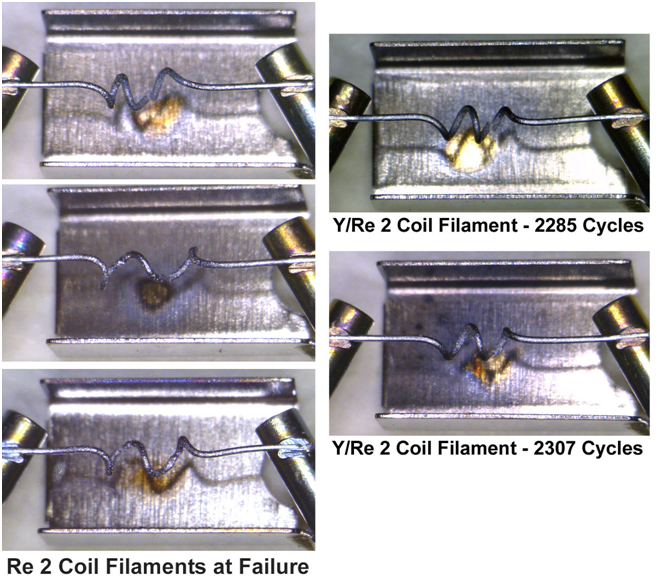
Coil Filaments - 3 Coils
Three coil filaments were constructed from 0.003” diameter Yttria/Rhenium alloy and pure Rhenium. Testing was done in both the SIS filament testing station using a DC power supply and also in a standard Mass spectrometer which also operated with a DC filament power supply. Two different lots of Y/Re were tested to verify the repeatability of the alloy properties.
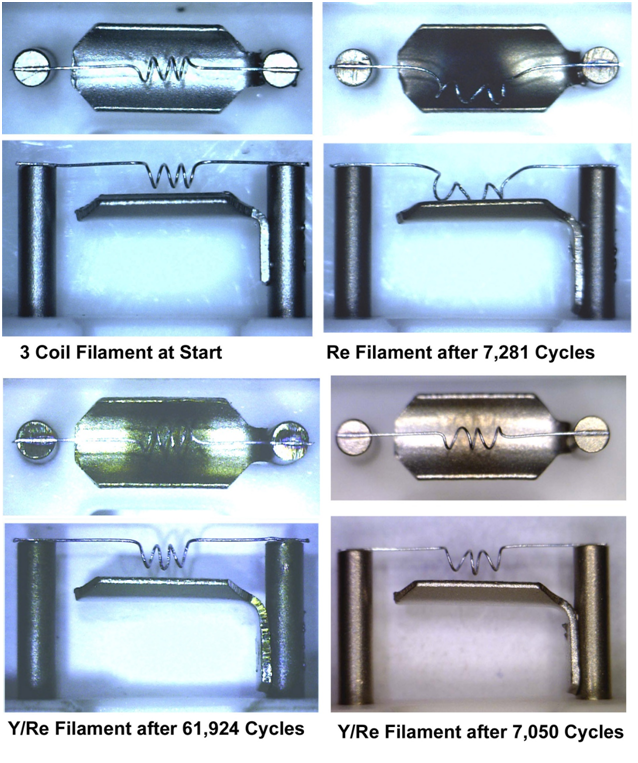
A second Y-Re filament was run to confirm that that the filament did not warp. The filament was stopped after 7,000 cycles due to a power failure in the facility. A new lot (lot 3) of Y/Re wire was made and allowed to run until the filament broke at 25,175 cycles.
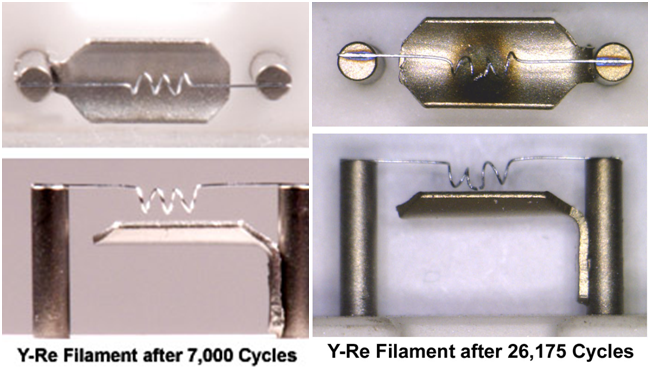
Coil Filaments - 4 Coils
Three coil filaments were constructed from 0.0055” diameter 3%Re/97% Tungsten alloy and pure Rhenium. Testing was done in an EI mass spectrometer using a high frequency AC filament power supply. The Re filaments demonstrate the consistent warping seen with pure rhenium filaments, where as the Re/W alloy filaments did not exhibit this warping.
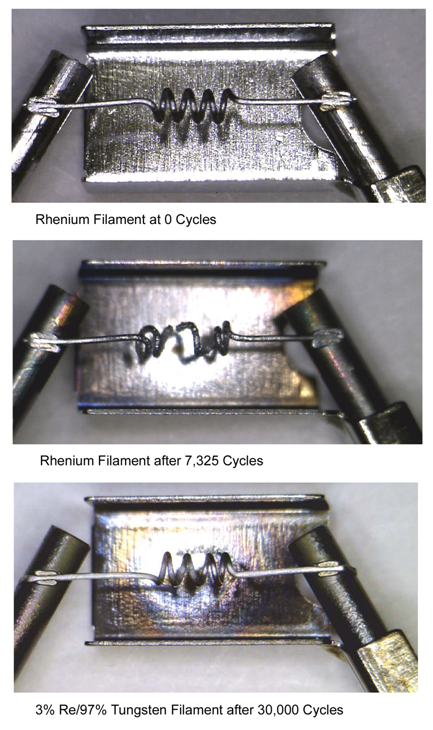
Four Coil Filaments constructed from SISAlloy®. These filament compare to the Tungsten/Rhenium filament above with minimal warping of the filament, unlike the pure rhenium filament.
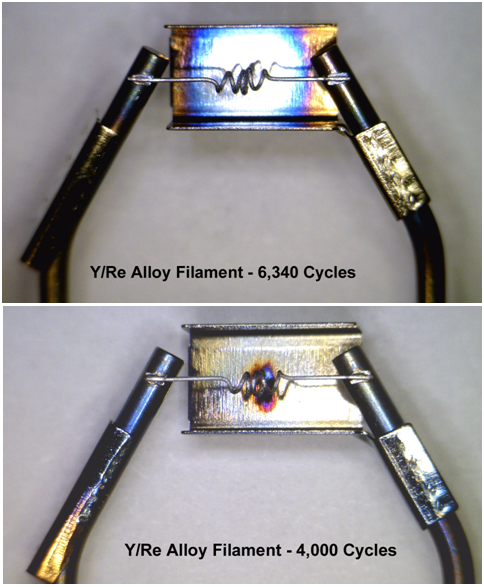
Coil Filaments - 4 Coils with Long Leads
Four coil filaments were constructed from 0.0055” diameter Yttria/Rhenium alloy, and pure Rhenium. The filaments were constructed with long leads which would theoretically exhibit the greatest degree of warping.Testing was done in an EI mass spectrometer using a high frequency AC filament power supply. The Re filaments demonstrate the consistent warping seen with pure rhenium filaments, where as the Re/W alloy filaments did not exhibit this warping, even with the long leads.
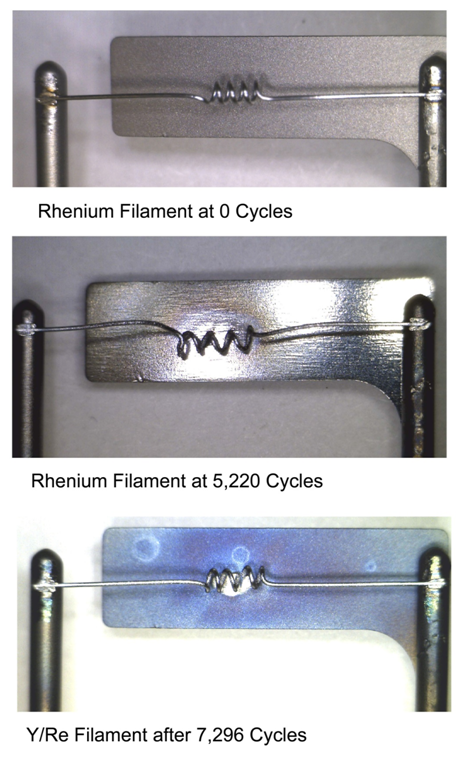
Pin Shaped Filaments
Pin shaped filaments were constructed from 0.004” diameter Yttria/Rhenium alloy and pure Rhenium. Testing was done in the SIS filament testing station using a DC power supply.
The filament voltage and current profiles were near identical for both materials as reported above. In both testing systems the Yttria/Rhenium alloy filament demonstrated less filament warping and increased filament lifetimes.
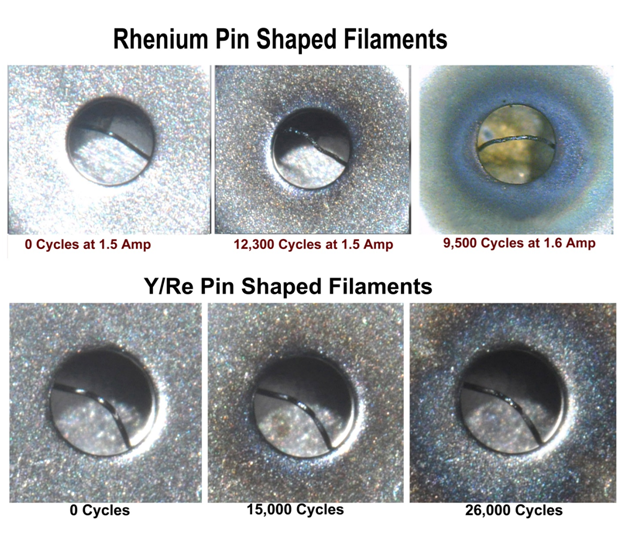
Crystal Structure of Rhenium alloys
Electron microscopy studies demonstrated that the yttria oxide particles intermixed with the rhenium particles which minimized the grain growth in the alloy filament. In comparison, the pure rhenium filaments exhibited larger and longer grain sizes. This smaller grain size in the alloy filament appears to strengthen the filament wire to provide a more stable filament that displays less sag or warping than pure rhenium filaments. The property of holding its shape has been demonstrated for straight wire filaments, multiple coiled filaments and pin shaped filaments when used in both AC and DC filament operating circuits.
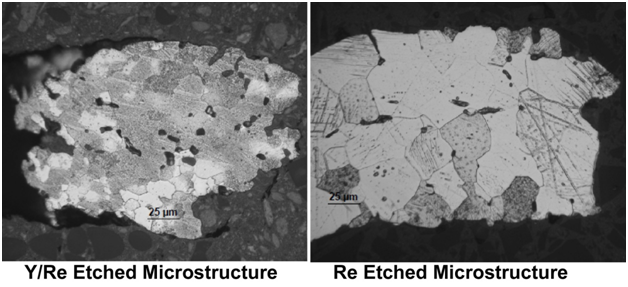
Conclusion
The purity of Rhenium appears to have improved over the last twenty years. This has resulted in rhenium wire with large grain size, often approaching the diameter of the filament wire. This large grain size is not optimal for filament production and results in premature filament failure in warping or breaking of the filament.
In this study Tungsten/Rhenium and Yttria/Rhenium alloys have demonstrated improved filament performance, by reducing or eliminating filament warping.
Historically Tungsten/Rhenium alloy filaments have been widely used in mass spectrometers, but tungsten is subject to tungsten oxide build-ups on the filaments when used in the mass spectrometer, which may not be desirable for most applications.
A Yttria/Rhenium alloy has been developed for use in filaments for mass spectrometers and other scientific instruments. Studies on the Yttria/Rhenium alloy filaments in a number of commercial mass spectrometers has demonstrated increased cycle lifetime as compared to the standard rhenium filaments.
The enhanced properties attributed to the addition of Yttria to the Rhenium alter the crystal structure of the Rhenium and result in the reduction of sagging and warping of the filaments. This permits the use of this alloy to produce not only straight wire filaments but also multiple coil shaped filaments and pin shaped filaments that are more stable and less likely to warp or change shape when used at elevated temperatures.

